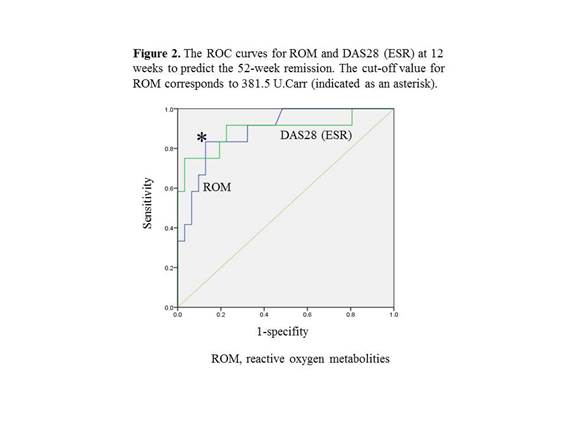Session Information
Date: Tuesday, November 15, 2016
Title: Rheumatoid Arthritis – Small Molecules, Biologics and Gene Therapy - Poster III
Session Type: ACR Poster Session C
Session Time: 9:00AM-11:00AM
Background/Purpose: Oxidative stress induced by reactive oxygen species is thought to be an important mechanism that underlies joint destruction and synovial proliferation. We have shown that serum levels of reactive oxygen metabolities (ROM) were associated with CRP and DAS28 in patients with rheumatoid arthritis (RA) and reduced temporally by the treatment with biologic agents (BAs). However, its clinical significance as a biomarker has not been elucidated.
Methods: Forty-eight BAs-naïve RA patients (mean age: 59.3}13.9 y, disease duration: 7.56}11.2 y) were included in this study. Association between serum levels of ROM, CRP, MMP-3, DAS28 (ESR) and HAQ at 12 weeks during the treatment and the remission in DAS28 (ESR) at 52 weeks was investigated. To measure ROM, the d-ROM test was performed using the FRAS4 analyzer (Wismarl, Italy). In order to identify predictor(s) for the 52-week remission, a multivariate logistic regression analysis was performed and an ROC analysis was also performed to determine their cut-off values.
Results: DAS28 (ESR) at baseline was 4.80}1.21 but decreased to 2.23}1.89 at 52 weeks and the remission rate was 70.8%. The serum level of ROM at baseline in the remission group (N=34) was 527.1}131.7 U.Carr (normal range <300 U.Carr), decreased to 334.9}79.1 at 4 weeks, and kept low levels after 12 weeks. On the other hand, in the non-remission group (N=14), the serum level of ROM at baseline was 592.2}112.9 U.Carr, decreased to 449.6}151.7 at 4 weeks, but gradually increased after 12 weeks (Figure 1). Significant factors at 12 weeks between the remission and non-remission group were ROM, CRP, MMP-3, DAS28 (ESR) and HAQ (P <0.05), which were then subject to a multivariate logistic regression analysis. As a result, ROM, other than DAS28 (ESR), was extracted as a predictor for the 52-week remission (odds ratio: 0.985, 95% CI: 0.97-1.000). An AUC of the ROC curve was 0.891, and the cut-off value of ROM that discriminated remission from non-remission was determined to be 381.5 U.Carr (sensitivity: 0.833, specificity: 0.871; Figure 2).
Conclusion: These results suggest that CRP, MMP-3 and HAQ cannot be a predictor for the remission during early stage of treatment with BAs. Instead, ROM at 12 weeks is able to predict the 52-week remission with high accuracy. The serum level of ROM could be a useful biomarker to achieve the remission in the current treat-to-target strategy for RA. 

To cite this abstract in AMA style:
Nakajima A, Yamamoto K, Nakagawa K. The Serum Level of Reactive Oxygen Metabolities (ROM) at 12 Weeks during Treatment with Biologic Agents for Rheumatoid Arthritis Is a Predictor for the 52-Week Remission [abstract]. Arthritis Rheumatol. 2016; 68 (suppl 10). https://acrabstracts.org/abstract/the-serum-level-of-reactive-oxygen-metabolities-rom-at-12-weeks-during-treatment-with-biologic-agents-for-rheumatoid-arthritis-is-a-predictor-for-the-52-week-remission/. Accessed .« Back to 2016 ACR/ARHP Annual Meeting
ACR Meeting Abstracts - https://acrabstracts.org/abstract/the-serum-level-of-reactive-oxygen-metabolities-rom-at-12-weeks-during-treatment-with-biologic-agents-for-rheumatoid-arthritis-is-a-predictor-for-the-52-week-remission/
